Long term lurker, new poster.
I’m trying to further educate myself on the hoof so I can further advocate for my horse. I’ll provide some background below, but my main question is what is the “right way” (or is there one) to start to correct long toes? From the bottom? By top dressing (the bottom 1/3, NOT higher), both? Essentially, I’d really like to ensure the corrections we are making keep us moving in the right direction.
Horse is barefoot, and I plan to keep him that way. I don’t want to share too many specifics as I don’t want to be potentially identifiable by the situation.
The “vague” background:
-Full set of PPE front hoof x-rays at purchase a few years ago - looked great
- He is barefoot today, I do use boots on his fronts for things like hacking, but he doesn’t need them for soundness - he is sound barefoot, I like the extra protection/shock absorption of boots
-He has tended toward “butt crack”/thrushy frogs and his feet are a bit small conformationally (QH-type)
-Nutrition is (now) balanced (done with a nutritionist). We recently added copper/zinc as bloodwork showed he was mildly low on copper
-This winter, toes seemed to be long and starting to “flare” out, he seemed to be dragging them, and the heel was starting to look underrun.
-We have had a WET few months, so the environment has not been ideal, but it’s starting to dry. I started actively/aggressively treating frogs for thrush with my own homemade “artimud” and white lightning. They have been slowly but steadily improving and opening up. My cotton balls no longer stay in.
-Updated x-rays recently done (full set on front, lateral views of hinds). These were done when he was “due” for a trim. They showed extra toe, and neutral or negative palmar/plantar angles on all 4.
-I’ve been down a RABBIT HOLE watching videos, reading, etc. He was trimmed and my farrier was good about discussing the plan to correct with me. They opted to top dress (the bottom 1/3rd) to address the toe flare, and brought heels more underneath (they still need to come back more). The improvement was significant looking from pre-trim and much closer to what his feet looked like when I bought him.
I am trying to ensure I’ve got nutrition, frog health, movement, and trim accounted for, as I can’t control the weather 
I guess I’m just looking for some perspectives on the “right way” to correct long toe and bring the hoof back in balance, and to make sure I know what to look for and keep on top of with my farrier. There are also 100 different opinions and “methods” and it’s hard to know what is “true” so to speak. I really am just interested in the COTH experiences and anecdotes…
Thanks for reading!



 It’s got good pictures of the structures, and good before/afters, as well as pretty good higher level instruction on what to trim and why.
It’s got good pictures of the structures, and good before/afters, as well as pretty good higher level instruction on what to trim and why. Either they don’t know what they don’t know so CAN’T fix things, or they do know but get lazy and while they might improve or even fix things in the short term, they’ll just get lazy again. Unfortunately, I also realize so many live in a HCP “desert” and there simply isn’t anyone else better.
Either they don’t know what they don’t know so CAN’T fix things, or they do know but get lazy and while they might improve or even fix things in the short term, they’ll just get lazy again. Unfortunately, I also realize so many live in a HCP “desert” and there simply isn’t anyone else better.